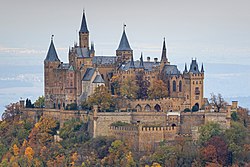| Baden-Württemberg | |
 | |
| location | |
 | |
| Flag | |
.svg/108px-Flag_of_Baden-Württemberg_(state,_greater_arms).svg.png) | |
| Main information | |
| Capital city | Stuttgart |
| Currency | euro |
| Surface | 35 742 |
| Population | 11 069 533 |
| Tongue | German |
Baden-Württemberg - a federal state in the south German. It borders with the Länder: Bavaria, Hesse and Rhineland-Palatinate.
Characteristic
Geography
It lies along the western border of the Upper Rhine Lowlands, which is bordered in the east by a mountain range Black Forestand to the northeast, the mountains Odenwald. Most of Baden-Württemberg belongs to the river basin Rhine (main tributary - Neckar), flowing on the border with France, remained in the basin Danube. It lies on the Swiss border Lake Constance.
Climate
Similar to Polish, typically Central European, moderate with Alpine influences.
History
From 1576, the states of Hohenzollern-Sigmaringen and Hohenzollern-Hechingen existed between Baden and Württemberg. The northwestern part of today's federal state belonged to the Rhenish Palatinate, which in turn belonged to Bavaria from 1777, and parts of Breisberg and Swabia were under the rule of the Austrian Habsburgs. In the 17th century, part of Breisgau, including Freiburg im Breisgau, belonged to France. In 1771, Baden was reunited into one state. In 1803, Baden and Württemberg were transformed into electorates, and in 1806, Baden became a Grand Duchy and Württemberg a Kingdom.
The federal state of Baden-Württemberg was created in 1952 by the amalgamation of three federal states: Baden, Württemberg-Baden and Württemberg-Hohenzollern.
Policy
- Prime Minister: Winfried Kretschmann (Greens)
- Ruling party: Greens-SPD coalition
- Last elections: March 13, 2016.
- Next elections: 2021
An administrative division
Baden-Württemberg is divided into 35 poviats and nine cities with poviat rights, which together form four regency districts (regencies) as units of local administration. Baden-Württemberg is also divided into twelve regions responsible for, among other things, spatial planning and the organization of the insurance system. One region consists of several counties.
Regency districts (Regierungsbezirke): Freiburg, Karlsruhe, Stuttgart and Tübingen
Regions (Regionen): Bodensee-Oberschwaben, Donau-Iller, Heilbronn-Franken, Hochrhein-Bodensee, Mittlerer Oberrhein, Neckar-Alb, Nordschwarzwald, Ostwürttemberg, Rhein-Neckar, Schwarzwald-Baar-Heuberg, Stuttgart, Südlicher Oberrhein in Baden-Württemberg
Land counties (Landkreise): Alb-Donau (UL), Biberach (BC), Böblingen (BB), Breisgau-Hochschwarzwald (FR), Calw (CW), Emmendingen (EM), Enz (PF), Esslingen (ES), Freudenstadt (FDS) , Göppingen (GP), Heidenheim (HDH), Heilbronn (HN), Hohenlohe (KÜN), Bodensee (FN), Karlsruhe (KA), Konstancja (KN), Lörrach (LÖ), Ludwigsburg (LB), Main-Tauber ( TBB), Neckar-Odenwald (MOS), Ortenau (OG), Ostalb (AA), Rastatt (RA), Ravensburg (RV), Rems-Murr (WN), Reutlingen (RT), Rhein-Neckar (HD), Rottweil (RW), Schwäbisch Hall (SHA), Schwarzwald-Baar (VS), Sigmaringen (SIG), Tübingen (TÜ), Tuttlingen (TUT), Waldshut (WT), Zollernalb (BL)
Cities with poviat rights (Stadtkreise): Baden-Baden (BAD), Freiburg im Breisgau (FR), Heidelberg (HD), Heilbronn (HN), Karlsruhe (KA), Mannheim (MA), Pforzheim (PF), Stuttgart (S), Ulm (UL) '
Economy
As of September 30, 2011, 132,629 enterprises were registered in the federal state. They employed approximately 729,000 people. The turnover was EUR 80 billion.
The region has the automotive industry (the main center of the automotive industry in Germany - Daimler AG, Porsche, Bosch), machinery, electrotechnical and electronic, optical, precision (especially watchmaking), as well as textiles, clothing and chemicals. Mining is of minor importance (rock salt). Cereals, sugar beets, tobacco, hops, potatoes, vegetables and grapevines are grown here.
Drive
By car
Baden and Württemberg are regions with well-organized communication. 15 highways (A5, A6, A7, A8, A60, A61, A65, A81, A96, A98, A831, A833, A861, A862 and A864) and several dozen national roads run through the region. Access to the land, from the side Polish runs through Saxony, Thuringia and Bavaria. You can also get from the north, from the side Hesse. The shortest route from southern Poland is through the Czech Republic.
By train
The best way to get to Baden-Württemberg is via The Czech Republic and the neighboring one Bavaria. There is a very well-developed railway communication in the region, thanks to which the trains run faster than in Poland.
By plane
By ship
Cities
- Baden-Baden
- Böblingen
- Freiburg
- Heidelberg
- Heilbronn
- Karlsruhe
- Constance
- Lörrach
- Ludwigsburg
- Mannheim
- Offenburg
- Pforzheim
- Rastatt
- Schwäbisch Hall
- Stuttgart
- Ulm
Interesting places
The main attractions of the state include:
- Heidelberg Castle
- Lake Constance
- Seeschloss Monrepos Palace
- Teamwelt in Höchenschwand
- Monastery in Bebenhausen
- Cathedral in Freiburg im Breisgau
- Ulm Cathedral
- Fishermen's Quarter in Ulm
- Mercedes-Benz Welt in Stuttgart

